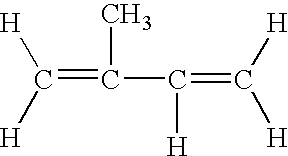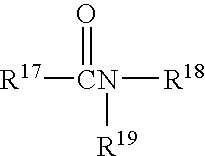Inhibition of exoprotein production using isoprenoid compositions
a technology of isoprenoid composition and inhibition of exoprotein production, which is applied in the direction of drug compositions, biocide, animal husbandry, etc., can solve the problems of difficult to eradicate i>s. aureus /i>bacterium without harming members, and the use of antibiotics that kill i>s. aureus /i>bacterium is not an option, and the effect of inhibiting the production of exoproteins
- Summary
- Abstract
- Description
- Claims
- Application Information
AI Technical Summary
Benefits of technology
Problems solved by technology
Method used
Image
Examples
example 1
[0076]In this Example, the effect of terpineol on the growth of S. aureus and the production of TSST-1 was determined. Terpineol, in the desired concentration (expressed in percent of terpineol) was placed in 10 mL of a growth medium in a sterile, 50 mL conical polypropylene tube (Sarstedt, Inc. Newton N.C.).
[0077]The growth medium was prepared by dissolving 37 grams of brain heart infusion broth (BHI) (Difco Laboratories, Cockeysville, Md.) in 880 mL of distilled water and sterilizing the broth according to the manufacturer's instructions. The BHI was supplemented with fetal bovine serum (FBS) (100 mL) (Sigma Chemical Company, St. Louis, Mo.). Hexahydrate of magnesium chloride (0.021 M, 10 mL) (Sigma Chemical Company, St. Louis, Mo.) was added to the BHI-FBS mixture. Finally, L-glutamine (0.027 M, 10 mL) (Sigma Chemical Company, St. Louis, Mo.) was added to the mixture.
[0078]Terpineol was added directly to the growth medium and diluted in growth medium to obtain the desired final c...
example 2
[0086]In this Example, the effect of menthol on the growth of S. aureus and the production of TSST-1 was determined. Menthol (Sigma Chemical Company, St. Louis, Mo.) was dissolved in methanol, spectrophotometric grade, at a concentration that permitted the addition of 200 microliters of the solution to 10 mL of growth medium for the highest concentration tested. The effect of the menthol tested in this Example was determined by placing the desired concentration, expressed in percent of the menthol, in 10 mL of a growth medium as described in Example 1. The test compound was then tested and evaluated as in Example 1.
[0087]In accordance with the present invention, Table 2 shows that S. aureus (MN8), when compared to the control, produced significantly less TSST-1 in the presence of the menthol. The menthol reduced the amount of exotoxin production by about 97%. However, although the amount of toxin produced was significantly reduced, there was minimal, if any, effect on the growth of ...
example 3
[0089]In this Example, the growth of S. aureus and the production of TSST-1 in the presence of various monoterpenes (Sigma Chemical Company) was measured. Test compounds were received as liquids or solids. The liquids were added directly to the growth medium and diluted in growth medium to obtain the desired final concentrations. The solids wee dissolved in methanol, spectrophotometric grade (Sigma Chemical Company) at a concentration that permitted the addition of 200 microliters of the solution to 10 mL of growth medium for the highest concentration tested. Each test compound that was dissolved in methanol was added to the growth medium in the amount necessary to obtain the desired final concentration. The effect of the monoterpenes was determined by placing the desired concentration, expressed in percent of the monoterpene, in 10 mL of a growth medium prepared as in Example 1. The monoterpenes were then tested and evaluated as in Example 1. Table 3 below shows that S. aureus, whe...
PUM
 Login to View More
Login to View More Abstract
Description
Claims
Application Information
 Login to View More
Login to View More - R&D
- Intellectual Property
- Life Sciences
- Materials
- Tech Scout
- Unparalleled Data Quality
- Higher Quality Content
- 60% Fewer Hallucinations
Browse by: Latest US Patents, China's latest patents, Technical Efficacy Thesaurus, Application Domain, Technology Topic, Popular Technical Reports.
© 2025 PatSnap. All rights reserved.Legal|Privacy policy|Modern Slavery Act Transparency Statement|Sitemap|About US| Contact US: help@patsnap.com



